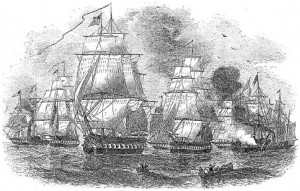
Nineteenth century world history was characterized by the expansion of world empires through trade, settlement and conquest. Imperialism was not a new idea. The idea of world empires was older than the Romans. Even after antiquity Imperialism had been practiced in North and South America, Africa, India and the East and West Indies during the fifteenth through eighteenth centuries. It was the nineteenth century, however, that gave rise to the popular phrase, “The Sun never sets on the British Empire”. The saying was true and it can be said for the French Empire as well. These world powers controlled vast amounts of territory across the globe. During the early nineteenth century, the United States was not preoccupied with the desire to conquer vast swathes of foreign territory, they were rather moving steadily westward on their own continent. American Expansionism was existent, simply not in the same way as French or British expansionism. Despite the American’s preoccupation with domestic expansion and more national affairs, they did not hesitate to establish trade with the rest of the world, even to the remotest parts of the earth.
In the year 1853 perhaps the most isolated part of the world was the Far East. China and Japan had declared themselves closed to trade with Western nations since the seventeenth century. The Far East was a land of mystery and was shrouded from the eyes of European curiosity. The Dutch had attempted to reopen the trade they had briefly enjoyed, but to no avail. In the early nineteenth century, the Americans had begun attempts to open Japan to trade. They too were unsuccessful.
In 1853, President Millard Fillmore sent a fleet of American ships to Japan under Commodore Matthew Perry. They set out from Norfolk, Virginia and arrived at Edo, Japan (modern-day Tokyo). Perry’s mission was to secure a trade treaty with the Japanese. The Japanese directed the American squadron to sail for Nagasaki, the only port in Japan open to foreigners. Perry used force in his persuasion of the Japanese. He had armed his “Black Ships”, as the Japanese called them, with cannons and threatened to bombard the Japanese town of Uraga if his demands were not met. The Japanese had no hope of competing against Perry’s superior technology so they agreed to begin negotiations. Perry sailed for China, leaving the Japanese to write up a treaty. He promised them that he would return.
Perry returned to Japan in early 1854. He signed the Convention of Kanagawa and sailed for home. Perry suggested that the United States control the island of Formosa (Taiwan) for better trade routes in the Far East. His idea was rejected by President Franklin Pierce. Perry was rewarded for his trip to Japan and trade was established with the Far East.
It did not take long for the Japanese to capitalize on the trade agreements they had made with the Westerners. They began to industrialize their nation and Japan experienced an influx of Western technology. While China resisted Western advances and fell behind technologically, Japan expanded and excelled. Within sixty years of signing the trade treaty with Perry, the Japanese vanquished the Russians in the brief Russo-Japanese War in 1904-1905. The Japanese had defeated a Western nation in warfare for the first time, but it wouldn’t be the last. During World War I, Japan overran German colonies in the Pacific Ocean and in China. During World War II, Japan would expand to great degrees, overrunning British, French, American and Dutch territory in the Far East, Asia and the Pacific.
